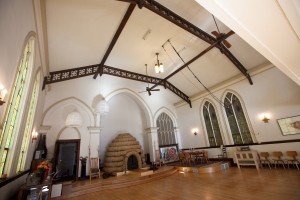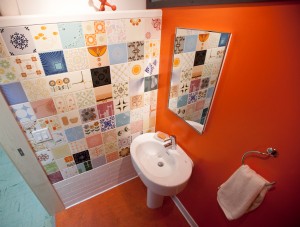Divine design
Spotlight, Style — By Sarah Karon
Isaac and Neis left the sanctuary largely intact. They use it to host fundraisers, film screenings and other events. Photo by Lukas Keapproth
Chele Isaac might have a church fetish. After all, she’s owned two.
“I’m a little embarrassed about that,” she tells me.
But it was a need for studio space, not religious fervor, that led Isaac — a former speed skater and sky-diving instructor — to buy her first church in Illinois over 20 years ago. After moving to Madison and selling her graphic design business in the late 1990s, she began hunting for a similar space. “I was thinking, ideally, of a factory,” says Isaac, an installation artist who has shown work in Wisconsin, Michigan and Pennsylvania. “But then I got a call about a church.”
More than a decade later, she and her husband, John Neis, are happily settled in a former Swedish Lutheran church on the east side of Madison. They’ve filled the cavernous Gothic Revival structure with a cheery mix of thrift shop finds, mid-century modern pieces and works by Isaac and the artists she admires.
Location: Madison, Wis.
Size: 10,800 square feet
Year built: 1922
Lived there since: 1999
Is there a third church in her future?
“I still get calls from real estate agents about churches,” she says. “And I’m like no, never, ever, ever again.”
It’s not often you find a trapeze in a church.
“I have a friend in Cycropia, the aerial dance troupe, who practices here… It seems ridiculous to have nearly 11,000 square feet for two people and a dog, and I find myself constantly trying to justify it, karmically. I want to make it a creative space for others, not just me … I want other people to feel at home here. So we host a lot of events: film screenings, dinners, weddings. We’ve had fundraisers for Tammy Baldwin, Jim Doyle and the Urban League.”

Isaac and Neis gutted the kitchen, and now it's one of their favorite rooms in the house. Isaac used acid to etch designs into the backsplash. Photo by Lukas Keapproth
What have you changed about the space?
“Everything. I worked really hard on this place for the first few years after we moved in. I did a ton of demolition, building, painting and plastering… The kitchen was a disaster. The windows were boarded up, and you’d open the lower cabinets and the inside went down to dirt. There was drywall, but it only went up eight feet … We found a giant crack in the wall and had to excavate the entire side yard.”
What’s your advice for people who are remodeling?
“Live in a space before you change anything. Ed Linville, the architect who designed all the Food Fight restaurants in Madison, told us that. He came into the kitchen when it was a mess … The walls were black, the previous tenants had painted the ceiling purple and I’d already started tearing down the drywall, which was lime green … And Ed comes in and says, ‘I wouldn’t do anything to this kitchen for a year.’ And I was like, ‘You’ve got to be kidding me.’
“But he was right … He wanted us to figure out how we used the space before we did anything. And I’m so happy we waited. We lived with it for a year, and where we were in the beginning and where we ended up is completely different.”
What’s been the biggest challenge about living here, from a design perspective?
“Figuring out how to bring things down to a human scale. We’ve tried to find ways to make it comfortable, cozy and bright. Paint helps — painting a wall to delineate a room, for example…
“[But] I hesitate to call what I do “design”… And that’s why it’s hard to pull something out, because I see this weird boatful of stuff as one thing… but anyone else who walks in here probably sees it as a bunch of little things… I hope it doesn’t seem like just a bomb of objects went off in this building.”
Do you and your husband have similar taste? Whose aesthetic is more represented here?
“I don’t want to say this is all me, because it’s not… I think he’s got really great taste. I would say I definitely bring the eclecticism; I bring to the mix everything that’s asymmetrical. Like when I put [a pair of matching] lamps at different heights, it almost blew his mind apart… He’s definitely got a sense of order…[but] he’s weird, too… I mean, John came up with red rhinoceros [in the living room].
“For me, objects are all about the connections between them, so I think that’s why our space tends to be more eclectic and a weird amalgam of things that all seem to hover in the same temperature of use and patina and humor… Everything operates at a similar vibration, if that makes sense.”
Has your taste changed?

The studio bathroom is decorated with 1970s tiles from Buenos Aires.
“I’m sort of the same person I was as a kid… [I’m] really intrigued by the serendipity of like, ‘Oh my God, that’s the seventh red enameled thing I’ve seen today, this is crazy’ … There’s something about objects that map histories for me, and it’s rare when I look at something and I can’t remember where I got it, or the story behind it.
“…I’ve often thought, what would happen if there was a massive fire, everything gone, then what would I do? Would I just have a room that looks like a page torn out of the West Elm catalog? Like, a little vase with one sprig in it? I will say this: I think I’m collecting a lot less stuff now than I used to.”
How did your parents influence your design sense?
“There was a mix of [antiques] amongst modern pieces [in my parents’ home], so I’m definitely a product of them. My parents were both artists… [and] taught us how to use our hands, early on… When I got in trouble and was sent to my room, I was always glad, because that’s where my art stuff was. It was never really a punishment.”
What’s your favorite place in the house?
“Places where I do a lot of reading, [like] the troll corner. And I do love the loft. Oh, but the kitchen. I like the kitchen when there are lots of people [here], but it’s great on Sunday mornings in the winter, when we’ll sit with a pot of coffee and two newspapers. You know what I mean? It’s a ritual.”
Tags: Church, Karon




 Digg This
Digg This Bookmark
Bookmark Stumble
Stumble